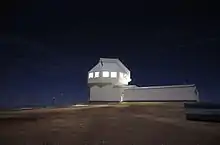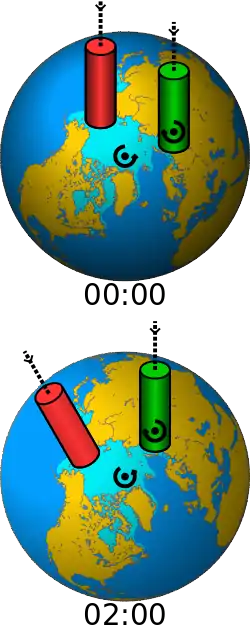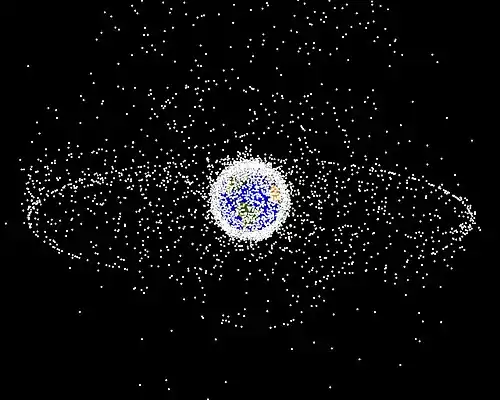Space Surveillance Telescope
The Space Surveillance Telescope is a telescope for detecting and tracking orbital debris. It has a 3.5 meter (138″) aperture mirror and came online in 2011.[1][2][3] Two noted design features include Mersenne-Schmidt type optics and a curved CCD.[4]
 Space Surveillance Telescope. DARPA | |
| Observatory code | G45 |
|---|---|
| First light | 2011 |
| Telescope style | optical telescope |
| Diameter | 3.5 m (11 ft 6 in) |
In 2017 the telescope, which was in New Mexico, United States, was transferred to United States Air Force Space Command and moved to Australia.[5][6] It will be ready for observations again in 2022, under the U.S. Space Force.[6][7][8]
Background
The discovery and tracking of space debris is noted as a growing problem in the 21st century.
One problem is that among the 20-30 thousand large objects in orbit that are tracked, and an estimated 100 million debris as small as paint flecks, it is difficult to find objects that are harder to track than the big objects, but big enough to be harder to shield against if they collide with a space asset.[9] Even paint flecks are known to cause damage because of the extreme speeds at which objects travel in orbit.[9] In other words, there are objects too big to easily shield against, but too small to track.[9] Another concern is the Kessler syndrome, a chain reaction of collisions, creating far more space debris dangerous for working satellites.[10] Another concern are near-Earth asteroids, and the SST can detect these objects as part of its mission.[11]
DARPA Space Surveillance Telescope program

The Space Surveillance Telescope program (SST) was DARPA's ground-based, advanced, optical system for detection and tracking of faint objects in space such as asteroids. It is also to be employed for space defense missions. The program is designed to advance, or expand, space situational awareness, and be able to quickly provide wide area search capability.
The SST is notable in the number of observations it makes and is currently listed by the Minor Planet Center as the world record holder for making the most observations in a single year. In its peak year so far (2015) it made a record 6.97 million observations, significantly more than any other telescope, including Pan-STARRS which is currently in second place, having recorded 5.25 million observations in its best year so far (2014).[12]
Telescope

The large curved focal surface array sensors are considered to be an innovative design. It encompasses improvements in detection sensitivity, has short focal length, wide field of view, and improvements in step-and-settle abilities. [note 1]
SST detects, tracks, and can discern small, obscure objects, in deep space with a "wide field of view system". It is a single telescope with the dual abilities. First the telescope is sensitive enough to allow for detection, also, of small, dimly lit objects (low reflectivity). Second it is capable of quickly searching the visible sky. This combination is a difficult achievement in a single telescope design.[13][14]
It is a Mersenne-Schmidt design with an F/1.0 aperture and a 3.5 meter primary mirror. It uses an array of charge-coupled device (CCD) sensors, arranged on a curved focal plane array. The SST mount uses an advanced servo-control technology, that makes it one of the quickest and most agile telescopes of its size. It has a field of view of 6 square degrees and can scan the visible sky in 6 clear nights down to apparent magnitude 20.5. These features allow the system to conduct multiple searches throughout the night, including the entire geostationary belt within its field. Unusually it does not have a field rotator and so is not able to track the movement of the sky as the Earth rotates. For this reason exposure times are limited to 2–3 seconds to prevent streaking due to movement of the sky during the exposure.[15]
As a telescope system, it can give precise locations of discovered objects, extrapolate the course of the object, and indicate the objects stability.[13][14][16]
The US Air Force ultimately took over the program and integrated the SST as a sensor in the Space Surveillance Network of the Air Force Space Command in 2009.[13][14]
Location
The SST was initially deployed for testing and evaluation at the White Sands Missile Range in New Mexico. On December 6, 2013, it was announced that the telescope system would be moved to the Naval Communication Station Harold E. Holt in Exmouth, Western Australia, as part of the Australia-U.S. Space Situational Awareness Initiative. From there it will able to observe the Southern Celestial Hemisphere and collect data for the US Space Surveillance Network. The SST system was originally expected to be operational in 2016, but was not moved until 2017. As of 1 October 2017, satellite imagery of its site at 21.8957° S, 114.0899° E, showed only partial completion of the installation.[16] Due to the new site being in a cyclone region, construction has been delayed.[17]
See also
References
- "Space Surveillance Telescope to Provide Enhanced View of Deep Space" (Press release). DARPA. Archived from the original on 15 April 2011. Retrieved 12 April 2011.
- "Telescope will track space junk". Nature. Retrieved 22 April 2011.
- Ackermann, Mark R.; McGraw, John T. "Large-Aperture, Three-Mirror Telescopes for Near-Earth Space Surveillance: A Look from the Outside In" (PDF).
- Report, Science World (2013-12-09). "New Space Surveillance Telescope Set to Locate Space Debris From Australia". Science World Report. Retrieved 2018-01-27.
- "U.S. Air Force takes control of the Space Surveillance Telescope ahead of Australian move". Digital Trends. 2016-10-22. Retrieved 2018-01-27.
- Erwin, Sandra (2020-04-23). "U.S. Space Force deploying surveillance telescope in Australia". SpaceNews. Retrieved 2020-04-24.
- "Exmouth telescope facility takes next step". The West Australian. 2019-05-23. Retrieved 2019-06-08.
- "CASG takes over space surveillance telescope - Australian Defence Magazine". www.australiandefence.com.au. Retrieved 2019-10-10.
- "Space agencies join forces to tackle problem of small debris in low Earth orbit". 2018-01-19. Retrieved 2018-01-27.
- "Space Junk Could Cause Catastrophic Satellite Collisions, Making Space Travel Impossible". International Business Times. 2017-04-27. Retrieved 2018-01-27.
- Davenport, Christian. "Pentagon's new telescope is designed to track space junk, watch out for asteroids". OrlandoSentinel.com. Retrieved 2018-01-27.
- "Residuals". Minor Planet Center. International Astronomical Uniion. Retrieved 22 October 2018.
- Pike, John (2010). "Space Surveillance Telescope" (Basic overview). GlobalSecurity.org. Retrieved 2010-05-20.
- Major Travis Blake, Ph.D., USAF, Program Manager (2010). "Space Surveillance Telescope (SST)" (Public Domain see Notes section). DARPA. Retrieved 2010-05-20.CS1 maint: multiple names: authors list (link)
- Ruprecht, Jessica D; Ushomirsky, Greg; Woods, Deborah F; Viggh, Herbert E M; Varey, Jacob; Cornell, Mark E; Stokes, Grant. "Asteroid Detection Results Using the Space Surveillance Telescope" (PDF). Defense Technical Information Center. DTIC. Retrieved 20 October 2018.
- "SST Australia: Signed, Sealed and Ready for Delivery" (Press release). DARPA. Archived from the original on 10 August 2014. Retrieved 18 August 2014.
- Terán, José; Hill, Derek; Ortega Gutiérrez, Alan; Lindh, Cory (2018). Spyromilio, Jason; Marshall, Heather K; Gilmozzi, Roberto (eds.). Design and construction of the SST Australia Observatory in a cyclonic region. The international society for optics and photonics. p. 5. doi:10.1117/12.2314722. ISBN 9781510619531. S2CID 115871925.
Notes
| Wikimedia Commons has media related to Space Surveillance Telescope. |
- DARPA Privacy and Security notice #2: Except where otherwise noted, information presented on the DARPA Web Information Service is considered public information and may be distributed or copied. Use of appropriate byline/photo/image credits is requested.
